Williams syndrome: symptoms, causes and treatment
The human being has approximately 25,000 genes within his organism. In spite of this great quantity, it is only necessary that some thirty disappear so that all kinds of congenital syndromes arise.
One of these conditions is Williams syndrome , a disease categorized as rare that confers on those who suffer it a series of characteristic facial features and an extroverted, sociable and empathetic personality.
- Related article: "Fragile X syndrome: causes, symptoms and treatment"
What is Williams syndrome?
Williams syndrome, also known as monosomy 7 , is a genetic disease with very little incidence, caused by a lack of genetic components on chromosome 7.
The first to describe Williams syndrome was the cardiologist J.C.P. Williams. Williams defects a series of symptoms that formed a strange clinical picture. Among these symptoms was a delay in mental development, a very distinctive facial face and a defect in the heart known as supravalvular aortic stenosis. Which consists of a narrowing of the aorta artery.
Interestingly, the German professor Alois Beuren described this same symptomatology almost simultaneously. So in Europe this disease is also known as the Williams-Beuren syndrome.
This strange genetic syndrome appears in approximately one of every 20,000 girls and boys born alive , and affects both men and women in the same proportion.
What is its symptomatology?
The clinical picture of Williams syndrome is characterized by presenting a wide symptomatology that affects a great number of systems and functions of the organism . This symptomatology can manifest itself at the neurological, cardiovascular, auditory and ocular systems, and facial features.
However, this symptomatology it usually does not appear before it is 2 or 3 years old nor do all the symptoms described below tend to converge.
1. Neurological and behavioral symptoms
- Mild or moderate intellectual disability.
- Mental asymmetry: difficulties may appear in some areas, such as the psychomotor area, while others remain intact, such as language.
- Sense of musicality very developed.
- Affectionate and affectionate personality: boys and girls uninhibited, enthusiastic and with preference for being surrounded by people .
- Slow development of motor skills and language acquisition, which varies from person to person.
2. Facial features
- Short nose and slightly upturned.
- Narrow front .
- Growth of the skin around the eyes.
- Protruding cheeks .
- Small jaw
- Altered dental occlusion.
- Bulky lips .
Cardiovascular symptoms
In 75% of cases a narrowing of the supravalvular aortic artery and the pulmonary artery appears . However, alterations may appear in other arteries or blood vessels.
Endocrine-metabolic symptoms
- Delay in the development of the endocrine system.
- It usually appears Transient hypercalcemia during childhood .
Musculoskeletal symptoms
- Column problems .
- Low muscle tone.
- Relaxation or contractures in the joints.
Cutaneous symptoms
Decreased elastin that causes signs of early aging .
Symptoms of the digestive system
- Chronic constipation.
- Tendency to inguinal hernias .
Symptoms of the genito-urinary system
- Trend to urinary tract infections
- Nephrocalcinosis .
- Tendency to nocturnal enuresis.
- Tendency to the formation of diverticula or abnormal cavities that form in the digestive system
Eye symptoms
- Myopia.
- Squint.
- Iris, starry .
Symptoms of the auditory system
- Hypersensitivity to sounds or hyperacusis.
- Tendency to ear infections during childhood.
What are the causes of this syndrome?
The origin of Williams syndrome is found in a loss of genetic material on chromosome 7, specifically in the 7q band 11.23 . This gene can come from either of the two parents and its size is so small that it is barely possible to detect it under a microscope.
However, despite the genetic origin of the syndrome this is not hereditary . The reason is that the alteration in the genetic material occurs before the formation of the embryo. That is, this loss of material comes along with the egg or sperm that will form the fetus.
Although there is still a lot of misinformation about Williams syndrome, it has been discovered that one of the genes that is not found in the chromosome is responsible for synthesizing elastin. The lack of this protein would be the cause of some symptoms such as stenosis , the tendency to suffer from hernias or the signs of premature aging.
How is it diagnosed?
Early detection of Williams syndrome is paramount so that parents have the opportunity to plan the child's treatment and follow-up options, as well as to avoid the accumulation of tests and explorations that do not have to be essential.
Today, more than 95% of cases of this syndrome are diagnosed early by molecular techniques. The most commonly used technique is known as fluorescent in situ hybridization (FISH), during which a reagent is applied to a portion of DNA on chromosome 7.
- Maybe you're interested: "Differences between DNA and RNA"
Is there a treatment?
Due to its genetic origin still no specific treatment for Williams syndrome has been established . However, specific interventions are carried out for those groups of symptoms that pose a problem for the person.
It is necessary that a multidisciplinary group of professionals be responsible for the treatment of Williams syndrome. Within this team should be neurologists, physical therapists, psychologists, psychopedagogues , etc.
With the aim of integrating these people both socially and laborly intervention is required through development therapy, language , and occupational therapy. Likewise, there are support groups for parents or relatives in charge of people with Williams syndrome in which they can find advice and support for care and day to day.



















